All things are created twice, first in the mind, and then in reality. Projects are no exception. Project professionals are constantly visualizing how the outcome will work after transitioning it to operations.
If we were to build the super lab from the famous series Breaking Bad, during the course of the project, we would be envisioning scenes like this:
Looking back into that future, we continuously envision the project’s decisive moment when the project ends and operations begin, which is the transition moment:
In all kind of projects, be them predictive, hybrid, or agile, it is effective for all involved parties (team members, project manager, program manager, portfolio manager, PMO, functional manager, sponsor, requester, and other stakeholders) to be able to distinguish in which management phase the project is now.
A project is a temporary endeavor undertaken to create a unique product, service, or result. Another, more contemporary definition, describes projects as temporary efforts to turn ideas into reality.
An agile project (= adaptive = value-driven = change-driven) is one in which, by its very nature, most requirements cannot be fully clarified at the beginning and should be progressively elaborated based on continuous feedback from stakeholders (= value) who regularly attend practical demonstrations to review increments toward the final outcome. Stakeholders can request changes at any time, even late in development. Changes are welcome if they deliver more value to the customer. The goal is to deliver the best possible outcome given the preallocated resources and available time.
A predictive project (= process-oriented = plan-driven) is defined in contrast to an agile project. In other words, the majority of the requirements, after a gathering effort, can be sufficiently clear from the beginning so that agreement is possible, and a professional schedule, cost, resource planning, etc., can be elaborated. Work is developed to deliver the outcome that meets the pre-agreed-upon requirements.
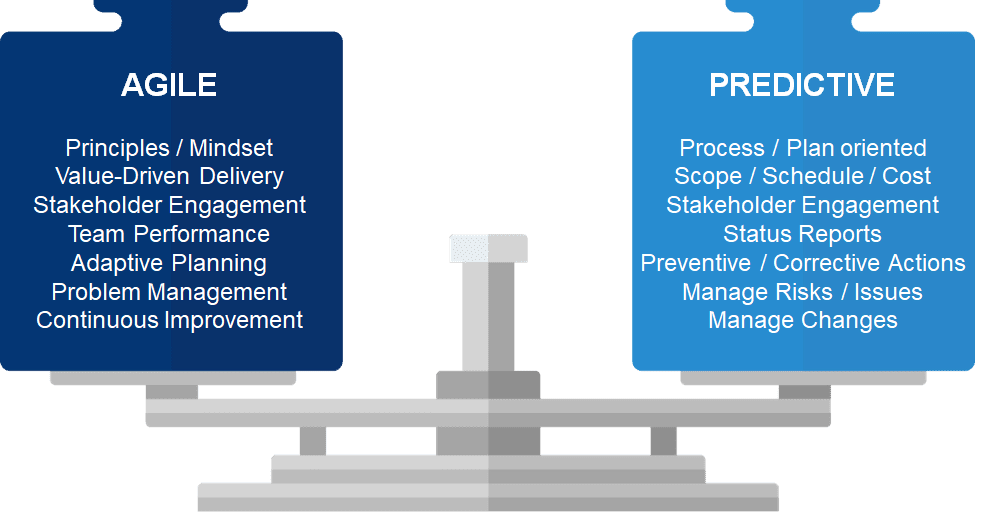
Hybrid projects are those which combine predictive and agile phases.
The professional project management standards distinguish 5 project management process groups:
- Initiating: Define a new project or a new phase of an existing project by obtaining authorization to start the project or phase.
- Planning: Establish the scope of the project, refine the objectives, and define the course of action required to attain the objectives that the project was undertaken to achieve.
- Executing: Complete the work defined in the project management plan to satisfy the project requirements.
- Monitoring and Controlling: Track, review, and regulate the progress and performance of the project; identify any areas in which changes to the plan are required; and initiate the corresponding changes.
- Closing: Formally complete or close the project, phase, or contract.
The execution and control processes occur simultaneously because control is based on the evidence from the work being executed, and the decisions made during control lead to new actions that need to be executed. The remaining process groups, except for initiation and closure, often overlap.
- In order to decide if the project should be approved or not (initiation), sometimes it’s necessary to estimate how long it will take or how much it will cost, or identify the major risks that should be accepted (planning). Alternatively, feasibility tests or proof of concept may need to be conducted, involving resources that cost money and must meet specific milestones (executing and controlling).
- While the project is in execution, new or more detailed information is often discovered, meaning that the plan should be improved.
- Sometimes, during formal closure, the need for rework may arise (execution).
Managers who are part of the project steering committee can practice effective project governance, even if they are not experts in professional project management. They can oversee technical phases and grant permission to proceed to the next one if the phase gate meeting is positive (or cancel the project early otherwise).
Project Management Phases
The life cycle for any project (or technical phase) can be reduced to 4 management phases:

- Initiating: The project has not been approved. Subject matter experts are discussing whether to proceed or not.
- Planning: Execution has not yet started, meaning no big cost incurred by technical resources. The project management team is putting efforts into modeling what needs to be done, when, by whom, how much it will cost, potential issues, and so on.
- Executing: Close attention should be paid because significant expenses are being incurred, and poor decisions can lead to further expenditure, project cancellation, and harm to the business, among other consequences.
- Closing: The technical work has been completed, and only the formalities remain to formally close the project or phase and transition the outcome to operations.
1. Initiating
The project has not been approved. Subject matter experts are discussing whether to proceed or not.
2. Planning
Execution has not yet started, meaning no big cost incurred by technical resources. The project management team is putting efforts into modeling what needs to be done, when, by whom, how much it will cost, potential issues, and so on.
3. Executing
Close attention should be paid because significant expenses are being incurred, and poor decisions can lead to further expenditure, project cancellation, and harm to the business, among other consequences.
During the execution phase, stakeholders receive timely updates on progress:
No less important, the project manager’s social skills are essential for leading the team and managing conflicts:
4. Closing
The technical work has been completed, and only the formalities remain to formally close the project or phase and transition the outcome to operations.
The project professional must be a good “closer.” Stakeholders must understand that they no longer have the right to request further changes, the project team has been released, and the outcome has been transitioned to operations.
Agile Project Lifecycle
In a predictive project, requirements are elaborated first, in order to set the project scope. Later on, we plan schedule and cost, etc., producing finally the project plan. A management model based on planning is followed:
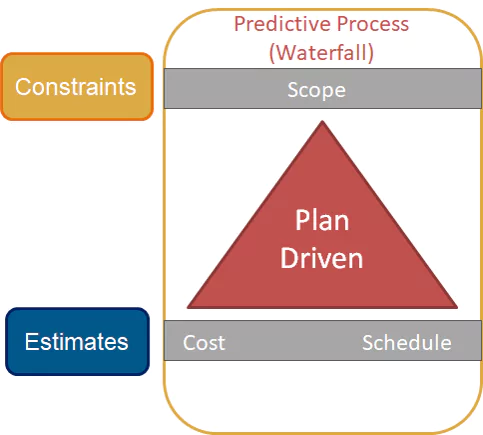
On the contrary, in an agile project, we can set the timeframe the business can wait to have the product done, let’s say 18 months, for instance. We can easily calculate the cost for a stable agile team of 8 people, for example. On the other hand, we need to estimate scope progressively, with the continuous engagement of stakeholders. We follow a value driven project management model. The agile project will fail if the stakeholders do not get along—they do not attend demonstrations or refinements meetings, they do not resolve impediments, etc.
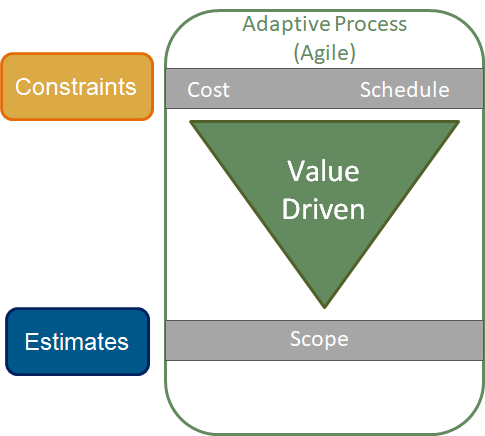
In agile projects, it’s also necessary to justify the initiation with subject matter experts and formalize the project closing. The difference from predictive projects lies in the fact that the upfront planning is typically very brief, just enough to plan the minimum viable product and subsequent releases. In practice, the project goes from initiating to executing. While executing, replanning is done based on continuous business feedback and value orientation.
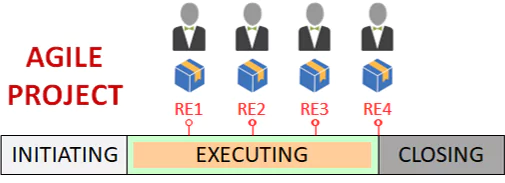
In agile projects, since the requirements are not clear, continuous iteration with stakeholders is needed to progressively discover value. The execution phase is divided into time boxes called releases, which usually last about 3 months. At the end of each release, a product that will be used by the stakeholders is transferred.
Features included inside a release are progressively elaborated. Each release is broken down into other time boxes called iterations, usually taking 2 weeks. At the end of each iteration, in a face-to-face meeting, the development team demonstrates the features to stakeholders, who provide immediate feedback.
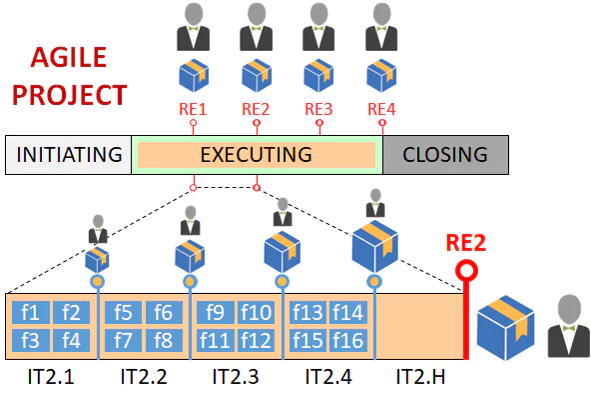
Agile projects normally follow an iterative-incremental lifecycle:

- Iterative means feedback is received at regular intervals.
- Incremental means that the product is elaborated “like the layers of an onion”: first the heart with the most important features and then the successive less important layers. The product grows with new features while refining the ones already built.
- In each demonstration, a potentially shippable increment is shown. If the release is cancelled any time, a working product could be delivered.
Normally, a release has about 5 iterations. The last iteration, called iteration H (hardening) is not aimed to produce more features, it is aimed to formal closing procedures and technical deployment to production environments.
Projects Lifecycle in PMPeople
PMPeople is the tool for the Project Economy. All types of organizations manage projects, programs, and portfolios to turn ideas into reality. Organizations are getting “projectified” and need project professionals to ensure predictability, accountability, and final success of each project.
Every user can see the project’s current state (initiation, planning, execution, closure, or archive). Managers can change the state in the control tab. When projects are presented as elements in a list, there is always a column for the state, and you can filter by this field. It’s important to distinguish the management phase or state (initiation, planning, execution, closure, or archive) from the technical phases of the project lifecycle, which the functional manager can model in the configuration of each business unit and can also be changed in the control tab.
PMPeople is a technology for project professionals to collaborate using roles. Launched in April 2018 for PMOs and project professionals using 12 collaborative roles to work in teams professionally, in the cloud, collaborating on projects, programs and portfolios.
PMPeople goes beyond simply following workflows, chains of supervision, processes, or document templates: it promotes people interact as individuals. Project Managers can manage projects at many organizations using predictive and agile frameworks. Stakeholders can supervise many projects and give feedback with their mobile application. Team members can know their teammates and job descriptions, submit comments, timesheets, expenses, etc.
PMPeople is aimed to unify professional project management by these differential points:
- Designed by and for professional project managers, following professional project management standards.
- Online productivity –less meetings, less documents, less workflows– through distributed collaboration among 12 specialized roles: Organization Owner, 6 roles on demand management and 5 roles on supply management.
- Freemium product –unlimited time, unlimited users– usable via web and mobile application.
Start using PMPeople for free, for unlimited time and for any number of users. In premium organizations, only managers have a cost. Several roles –stakeholders, team members, sponsors, and resource managers– are always free. You can increase or decrease your premium seats according to the organization’s actual needs. Premium organizations have access to our online interactive support. Our servers are located in the EU. This software can also be hosted on customer premises.
Jose Barato
Related posts
Categories
- Business (16)
- Demand Management Roles (14)
- Frequently Asked Questions (7)
- Guide (26)
- People (23)
- Assignments (2)
- Feedback (2)
- Project Team (3)
- Tracking Time And Expenses (2)
- Process (9)
- Closing (2)
- Executing And Controlling (2)
- Planning (1)
- Project Management (67)
- Management Frameworks (18)
- Organization Owner (OO) (3)
- Project Economy (54)
- Tools (19)
- Supply Management Roles (5)
- Training (6)
- Uncategorized (1)





